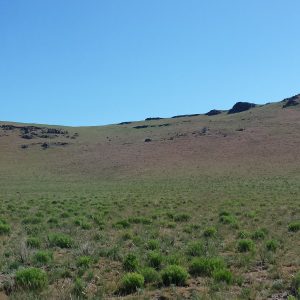The past month has been busy in Klamath Falls. Last week one of the damns from the Klamath Irrigation Project was shut down, so we went out with the Bureau of Reclamation to try and salvage some fish! To do this, we set tramp nets in the pool beneath the damn and we also electroshocked for fish in some of the smaller rocky pools beneath the damn. This was necessary because as the summer continues, the pools will either dry up or the oxygen levels will plummet, causing fish die off events. Both species of endangered suckers are found in the reservoir, so US Fish and Wildlife wanted to make sure as many individuals as possible were saved. We only found five suckers in the pools, but a lot of other fish including catfish and perch. The suckers that were caught were pit tagged to determine how well the fish are surviving in the reservoir after they are moved and how well they are moving through the river system. We also took general condition data on the suckers and took genetic samples.
I’ve also been working down at Lower Klamath National Wildlife Refuge. I’ve been taking water quality measurements as well as trapping the ponds to see if fish are able to move through the water supply channels. I still haven’t caught any fish in the smaller ponds, which is good. The largest pond should have fish in it, but I hadn’t caught any until last Friday. I caught four small Sacramento Perch. This is a little concerning because Perch eat suckers. They also grow much faster than suckers, making them easy prey. We still have not caught any suckers in the large pond, but we are getting larger traps, so hopefully we will be able to find them.
Earlier in the month we worked more with Applegate’s Milk-vetch. As part of the mitigation plan for reducing the impact of runway construction on the endangered Milk-vetch, seeds were to be collected from the plants along the runway. The seeds would then be taken to a nursery to be planted and grown to a certain size and then planted out at a Nature Conservancy preserve. This method was chosen because typically transplanting Milk-vetch has been unsuccessful, due to both a deep tap root and a close symbiotic relationship with mycorrhiza. There has been some success taking seeds and planting then with soil taken from sites where Applegate’s Milk-vetch already occurs.
Unfortunately this was not a good year for Milk-vetch. A lot of the plants at the airport had aborted the seeds in their fruits. In addition, Milk-vetch is a plant that annually dries out and goes underground. A lot of the largest plants, and the easiest ones to collect seeds from, had already begun to dry out. This meant that we will not be able to collect many seeds from the airport. Luckily some of the other populations were in better condition so we were able to bag plants at other locations. It was surprising to see how different the condition was of Milk-vetch in different populations.
I also helped a professor from the Oregon Institute of Technology. As part of the recovery effort for Milk-vetch, plants were grown up from seed and then planted at a preserve managed by The Nature Conservancy. This preserve was bought and is managed specifically for Milk-vetch. There is currently a demographic study on the out-planted Milk-vetch plants that is looking at survival and reproduction, a project looking at the wild plants just received funding from USFW. In addition, there is a study looking at the plants that grow around Milk-vetch to see if there is a correlation between survival and the plant community around Milk-vetch. This was a super fun survey to do because it meant that I got to learn a lot of new plants, including some common grasses. Can’t wait to see what the next month brings!





















